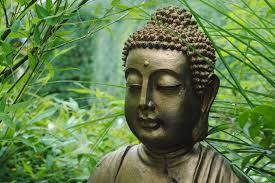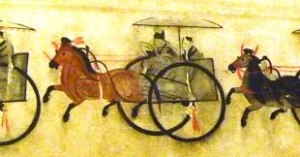
I relate to Buddhism not so much as a world view, religion or philosophy, but as a set of practices that can help us live very deeply.
The formal teachings are sort of like a road map. It doesn’t do much good to read or think about a map if we’re never actually going to hop in the car and go anywhere.
However, assuming we are prepared to hop in the “Buddhist vehicle” and engage with its practices, it’s very helpful to know the most important thing the map is actually saying.
To quote the Buddha himself, “I teach one thing and one thing only—dukkha and the end of dukkha.”
 The Meaning of Dukkha
The Meaning of Dukkha
Dukkha is a word from the Pali language, and is usually translated into English as suffering. However, the actual meaning is a 2,500 year old metaphor that’s somewhat lost in translation.
In Pali, a -kha is the hole at the center of a chariot wheel. -Du means bad. Putting it together, dukkha means a bad hole at the center of a chariot wheel. Think about driving a car with a crooked wheel. It would lead to a bumpy, unpleasant drive. Inversely, a “good hole” (sukkha), would produce a smooth, pleasant drive.
So, what the Buddha taught is that conventional life is a bumpy ride, but through various heart-mind trainings, we can learn to make it a smooth ride.
Often, people are initially put off by this teaching. They tend to over-focus on how the Buddha says “life is a bumpy ride,” and then think it’s just a depressing tradition that’s pessimistic about life.
However, the Buddha more strongly emphasized the “life can absolutely be a smooth ride” part. In reality, the entire tradition and all its practices are aimed at making our lives increasingly smoother, more joyful, contented and free. In other words, when engaged with as a set of practices rather than a thought in our head, it is profoundly inspiring!
Although, if there’s still some part of the brain that’s skeptical about the whole bumpy ride thing, it’s helpful to break that down a little.
For starters, I like to make a very non-technical distinction between two types of dukkha: obvious dukkha and not-so-obvious dukkha.
In the beginning, we only notice obvious bumpiness, like riding over a speed bump. As we go on, our sensitivity grows, and we start to notice not-so-obvious experiences, like riding over a pebble (and here’s where all this gets very exciting!).
1. Obvious Dukkha.
This is the stuff we usually associate with suffering. A loved one dies. Health declines. The economy tanks and we lose our job. We get hit by a car. Or we slip into various afflictive mental-emotional states, like depression, anxiety, panic, rage or complacency.
Obvious dukkha is when it’s clear as day that our wheel is crooked and life is bumpy.
2. Not-so-obvious Dukkha.
Until I was 19, I ate excessive amounts of fried food, candy, soda and red meat. I never knew another way of eating. However, after I got a job at a natural foods co-op, I slowly began eating more healthily.
About a year into that job, one day I went to eat my standard McDonalds order—two large fries and about a pound of ketchup. Afterward, I lucidly felt my gut sink and my mind get fuzzy. In that lucid perception, I had a life-changing insight.
Even though I had felt crappy most my life, I never realized it. For me, feeling low energy and mentally hazy was my “normal.” However, after that insight, I realized there was a better way to eat that produced steady energy and a clear mind. I vowed to never eat fast food again, and not before long, feeling clear-minded became my new “normal.”
In other words, our lives are filled with “blind spots.” Areas where we are oblivious to just how bumpy our ride is—and, so, when the Buddha says that conventional life is a bumpy ride, we disagree. However, when we develop a deep enough awareness, we realize increasingly subtle ways that our ride is actually far from smooth.
Here’s a more classically meditative example:
As a younger me, I had always greatly enjoyed my thought-life. I prided myself on my intellectual mind. All day long, fascinating thoughts were running through my mind-stream. This was my normal, my baseline—all I knew.
Then, about a year into my intensive retreat, I got to a point where my mind had become pretty quiet. I felt a much deeper sense of peacefulness and lucidity than I had ever experienced before.
Previously, I had thought that all my thinking was bringing me happiness—a smooth ride. However, after building my awareness practice, I realized all that thinking was actually producing a subtle type of nausea.
In other words, the process of meditation is about developing our awareness skills so every little bump in the road becomes obvious. From there, we begin to deeply understand how to actually start riding smoothly, all the time.
 The Not-So-Obvious Roots of Bumpiness
The Not-So-Obvious Roots of Bumpiness
In the Buddhist understanding, the basic cause of dukkha is another pali word, called upadana. This translates to something like clinging, identification, grasping or attachment.
Any time we cling onto a thought, an emotion, an idea or a life situation, we experience dukkha. The challenge is that most of the places we cling are automatic and blind.
Initially, meditation practice is largely about just starting to make obvious all those clingings. One classic example is new meditators realizing just how often their mind wanders off (aka identifies with thoughts!).
Another common example is our relationship with emotion. Before meditation, emotions tends to be very “sticky.” We get caught in a vortex of anxiety, irritability, depression or any number of other states. It’s like they have us in a trance, and our only options seem to be cathartic expression or ignoring it.
After meditating for a while, we learn how we to deeply feel emotion without identifying with it—and, instantly, our ride becomes much smoother.
As a complete system for awakening, mindfulness meditation is about building up awareness, lucidly seeing our patterns of clinging, and, through that depth of lucidity, letting go of our bumpy ways (like when I gave up junk food and compulsive thinking).
 From Dukkha To The Rest of Your Life
From Dukkha To The Rest of Your Life
There’s a famous Buddhist quote that says, “pain is mandatory, but suffering is optional.”
We will inevitably experience health problems, the loss of loved ones, piercingly loud noises, turbulent life transitions and periods of difficult emotions. These things are what’s called “pain.” They are just a part of being human.
Inversely, suffering/dukkha is what happens when we cling onto our pain or other aspects of our experience. This is not inevitable; it is optional.
Through the various practices of the Buddhist tradition, we can learn to experience/feel our reality very deeply, but also allow it to flow right through without clinging.
One on level, this new relationship with life is intrinsically delightful, like taking a smooth ride on a long journey, getting to notice the scenery and being in the heart of moment all the time.
On another level, this is the ground that allows us to bring great love and compassion into the world. It’s what helps us focus and follow through. It’s what helps us to create a life that keeps on giving.
In summary, if we’re ready to not just think about spiritual practice, but to take action and DO SOMETHING ABOUT IT, then this teaching on dukkha is at once inspiring and liberating, showing us where our life is a little bumpy, and offering a framework and powerful set of tools to change it to being reliably smooth.
A great big Buddha bow!

Thank you David. Another informative and inspirational post. I have so much to learn and enjoy how you break it down, piece by piece so the bites are so overwhelming!
Peace ~
D’Alene